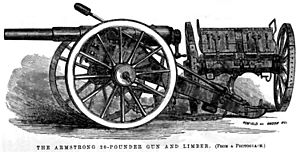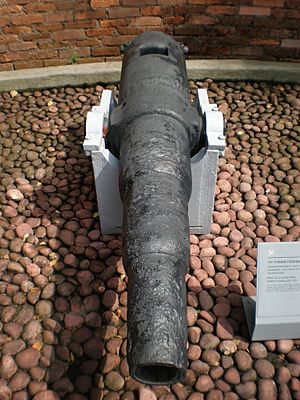RBL 20-pounder Armstrong gun facts for kids
Quick facts for kids RBL 20-pounder gun |
|
|---|---|

16 cwt field gun with limber
|
|
| Type | Naval gun Field gun |
| Place of origin | United Kingdom |
| Service history | |
| In service | 1859 – 19?? |
| Used by | British Empire |
| Production history | |
| Designer | W.G. Armstrong Co. |
| No. built | 412 |
| Variants | 13, 15 and 16 cwt |
| Specifications | |
| Mass | Naval : 13 long hundredweight (660 kg) or 15 long hundredweight (760 kg) Field : 16 long hundredweight (810 kg) |
| Barrel length | Naval : 54 inches (1.372 m) Field : 84 inches (2.134 m) bore & chamber |
|
|
|
| Shell | 21 pounds 13 ounces (9.894 kg) |
| Calibre | 3.75-inch (95.2 mm) |
| Breech | Armstrong screw with vertical sliding vent-piece (block) |
| Muzzle velocity | Naval : 1,000 feet per second (300 m/s) Field : 1,130 feet per second (340 m/s) |
| Effective firing range | 3,400 yards (3,100 m) |
The Armstrong Breech Loading 20-pounder gun, also known as the RBL 20-pounder, was an early type of modern cannon. It was a light gun, meaning it wasn't super heavy, and it was made in 1859. This gun was special because it used a new way to load ammunition from the back (breech-loading). It also had grooves inside its barrel (rifled) to make the shot fly straighter.
History
This gun was a bigger version of another successful cannon, the RBL 12 pounder 8 cwt Armstrong gun. The 20-pounder gun was made in different versions. Some were for use on land, and others were for use at sea on ships.
Sea service

The RBL 20-pounder guns for sea use were introduced in 1859. There were two main types: the 13 cwt and the 15 cwt. The "cwt" stands for "hundredweight," which is a unit of weight. These sea guns were about 2.5 feet shorter than the land versions. Their shorter barrel meant the cannonball didn't fly as fast when it left the gun.
The 15 cwt gun was heavier and used on the sides of sloops, which were types of warships. The lighter 13 cwt gun was called a "pinnace gun." It was designed to be used on smaller boats.
Land service
The RBL 20-pounder gun for land use was introduced in 1860. This version was heavier, weighing 16 cwt. It had a longer barrel, which made it look like a typical field gun. A field gun is a cannon used by armies on land.
Later, these guns were no longer used by the main Royal Artillery. However, some were given to volunteer artillery groups starting in 1889. These groups were called Batteries of Position. They used the 20-pounder guns along with other cannons. For example, a plan from 1893 showed that twelve volunteer artillery batteries with 20-pounder guns would gather in Epping, Essex if there was a need to mobilize.
Surviving examples
You can still see some of these old guns today:
- A 13 cwt pinnace gun that has not been restored is at the Hong Kong Museum of Coastal Defence.
- A 16 cwt gun is on board HMS Warrior in Portsmouth, UK.
- A 13 cwt gun from 1859 is at the Artillery Museum, North Head, Sydney, Australia. You can see a picture of it here: A 13 cwt gun dated 1859.
- A sea service gun is at the Explosion! Museum of Naval Firepower in Gosport.
See also
- Armstrong gun
- List of field guns
- List of naval guns

